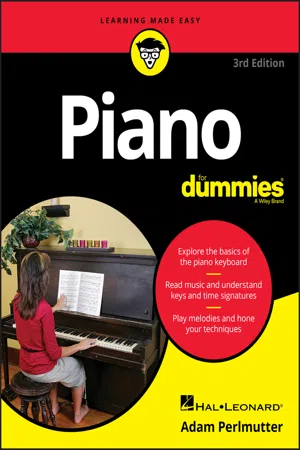
- English
- ePUB (mobile friendly)
- Available on iOS & Android
Piano For Dummies
About This Book
The key to fast and fun piano proficiency!
Whether you're a wannabe Mozart or are an experienced hand at tinkling the ivories, the latest edition of Piano For Dummies has what you need to take you to the next level in making beautiful music using this much-loved and versatile instrument. Working as an introductory course—or as a refresher to keep those fingers nimble—you'll find information on getting started, improving your technique and performance, and the best ways to practice until you hit finely tuned perfection. And, along the way, you'll pick up the techniques for different styles, including classical, blues, and rock.
In an easy-to-follow style, the book also helps you sharpen your sight-reading. You can also tune in to audio and video online to help you improve your creativity and discipline, as well as hear and see that you're hitting the right notes.
- Choose the right piano
- Know your keys
- Scale up for success
- Care for your instrument
Whatever you want from your love affair with the old "88, " you'll find enough right here to keep you hammering happily—and even more proficiently—away for years to come!
P.S. If you think this book seems familiar, you're probably right. The Dummies team updated the cover and design to give the book a fresh feel, but the content is the same as the previous release of Piano For Dummies (9781118900055). The book you see here shouldn't be considered a new or updated product. But if you're in the mood to learn something new, check out some of our other books. We're always writing about new topics!
Frequently asked questions
Information
Getting Started with Piano
Preparing to Play a Piano



Knowing Why the Piano Is So Special
- Playing different pitches and melodies
- Controlling the attack and release of a note
- Playing different dynamics (relative loudness and softness)
Advantages to playing the piano
- You can play many different notes at the same time. The fancy word for this characteristic is polyphonic.
- It’s a completely solo instrument. You can play a complete song or other musical work without requiring additional accompaniment or other help from your musical friends. That makes the piano satisfying and self-sufficient.
- It’s the perfect choice for accompaniment. You can accompany a singer, a choir, a dance class, a silent movie, your own opera, or your own soap opera, not to mention any other instrument.
- You can play almost anything on the piano. The piano has an unmatched repertoire of music. You name it, there’s piano music for it.
Advantages to studying music at the piano
A skill and an art
Understanding Why People Take Piano Lessons(And Why They Often Quit)
- You want to re-create your favorite songs and compositions. When you play a piece of music on the piano, you bring that music to life. Written music is like a blueprint — a set of directions that tell you what notes to play and when and how to play them. It takes a performer to complete the process that starts in the composer’s mind but is unfulfilled until the music reaches the listener’s ear.
- You like a challenge. There’s no doubt that getting to the intermediate and advanced levels of piano takes time, patience, and practice. Some people relish this challenge. Whatever your ambition, learning to play piano is a never-ending challenge given t...
Table of contents
- Cover
- Table of Contents
- Introduction
- Part 1: Getting Started with Piano
- Part 2: Deciphering Squiggles on Paper to Create Sound
- Part 3: One Hand at a Time
- Part 4: Living in Perfect Harmony
- Part 5: Technique Counts for Everything
- Part 6: The Part of Tens
- Appendix: About the Website: Audio Tracks and Video Clips
- Index
- About the Reviser
- Advertisement Page
- Connect with Dummies
- End User License Agreement